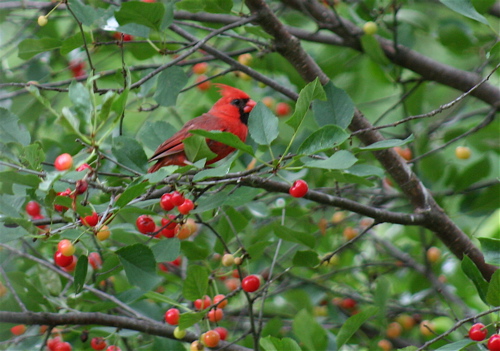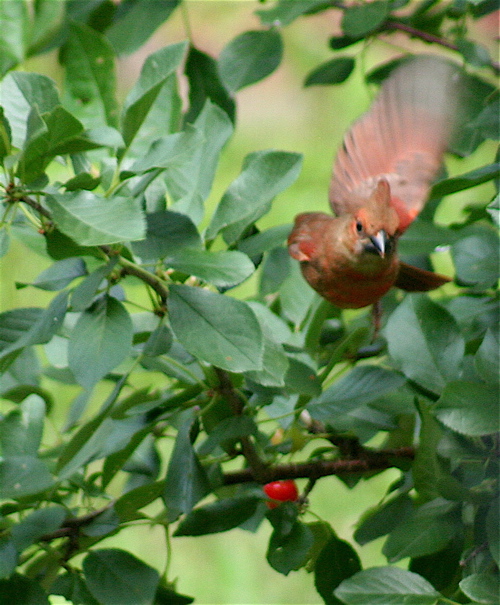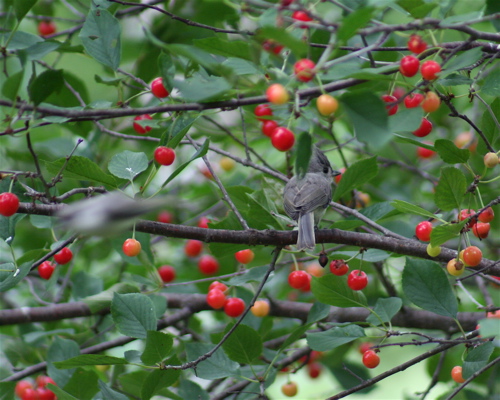 People often ask how I became a beekeeper. It was a conversation in Mr. Neil's office a few years ago. He said off hand while working on his computer, "I've always wanted to have bees on my property to pollinate my trees. My plum tree never has plums because we don't have bees."
People often ask how I became a beekeeper. It was a conversation in Mr. Neil's office a few years ago. He said off hand while working on his computer, "I've always wanted to have bees on my property to pollinate my trees. My plum tree never has plums because we don't have bees."
I was surfing the net on my laptop and said, "I've always wanted to keep bees, but can't in my apartment in Minneapolis."
There was a pause, we turned and looked at each other and a plan was hatched (amid much protestation from both my husband and Mr. Neil's personal assistant).
But now we have bees and happy trees with branches laden with fruit. Like the above cherry tree with a male cardinal lurking behind some leaves.
When the cherries are ripe, it's a race to gather as many on the bottom as possible before the birds swoop in. They are welcome to cherries at the top of the tree, but the ones within human reach would be nice for everyone else. Of course, it doesn't help that the cherry trees are located in the bird feeding area, but ah well. Above is a female cardinal. She and the male arrived with their young and were teaching them to each the cherries.
Here's a young male cardinal--note the black beak, that indicates he was hatched this summer. Poor guys, they just barely master landing on a bird feeder perch and feeding, now they have to figure out how to get at the juicy food hanging on the branch under him.
He was too wary of trying it while I had a camera lens aimed him and he awkwardly flew away. Pardon me, young cardinal. Oh, and piece of advice: I know I'm human and can't fly, but I think you might hone your awkward flight ability if you flap both wings at the same time. Just a suggestion.
Robins were especially cagey in the cherry trees. In some ways they were the easiest to find in the tree, being larger and flapping their wings as they tried to pull the cherries off the branch. Robins typically feed on the ground, so it must be a bit awkward for them to feed in the tree. They must know they are somewhat vulnerable as they are surrounded by leaves and unable to see aerial predators coming as easily. Plus, they are using their concentration to feed in a different way, and cannot focus their attention on predator watch. But I sampled some of the cherries under the tree as I was taking photos, they were tasty, I don't blame the robin for risking it to get at the juicy summer fruit. Poor robins, they eat quite a few worms, no wonder they are willing to risk their lives for these tart fruits.
The titmice were all over the cherries, above is one tufted titmouse perched on a branch and on the left, is a titmouse blur as that bird is flying to another branch.
They had a much easier time going for the cherries, they can easily hang upside down to get at nuts, so it was nothing for a titmouse to locate the cherry of their choice, flip under and start pecking away.
They could also go on the thinnest branches and not have to worry about their weight bending the branches like the robins and cardinals. Don't worry, Mr. Neil has had some of his cherries harvested, but it takes a quick eye to note when they are ripe to grab them before the birds do. They were lucky this year to have grabbed a few before the cedar waxwings found them.
So, if you are wondering what trees to plant or birds to attract them in your yard in summer--consider a cherry tree.







